NOD2 Polymorphisms and Their Association with Colorectal Cancer Risk: An Updated Systematic Review and Meta-Analysis
Simple Summary
Abstract
1. Introduction
2. Materials and Methods
2.1. Literature Search Strategy and Study Selection
2.2. Data Extraction and Quality Assessment
2.3. Statistical Analysis
3. Results
3.1. Characteristics of Studies
3.2. Quantitative Data Synthesis
3.3. Sensitivity Analysis
3.4. Publication Bias
4. Discussion
5. Conclusions
Supplementary Materials
Author Contributions
Funding
Data Availability Statement
Conflicts of Interest
References
- Ferlay, J.; Ervik, M.; Lam, F.; Colombet, M.; Mery, L.; Piñeros, M.; Znaor, A.; Soerjomataram, I.; Bray, F. Global Cancer Statistics 2022: GLOBOCAN Estimates of Incidence and Mortality Worldwide for 36 Cancers in 185 Countries. CA Cancer J. Clin. 2023, 73, 377–406. [Google Scholar]
- Zinkeng, A.; Taylor, F.L.; Cheong, S.H.; Song, H.; Merchant, J.L. Early Onset Colorectal Cancer: Molecular Underpinnings Accelerating Occurrence. Cell Mol. Gastroenterol. Hepatol. 2025, 19, 101425. [Google Scholar] [CrossRef] [PubMed]
- Tan, S.C. Low penetrance genetic polymorphisms as potential biomarkers for colorectal cancer predisposition. J. Gene Med. 2018, 20, e3010. [Google Scholar] [CrossRef]
- Papadakos, S.P.; Georgiadou, C.; Argyrou, A.; Michailidou, E.; Thanos, C.; Vogli, S.; Siakavellas, S.I.; Manolakopoulos, S.; Theocharis, S. Inflammatory Bowel Disease (IBD)-Associated Colorectal Cancer (CRC): Is cGAS-STING Pathway Targeting the Key to Chemoprevention? Int. J. Mol. Sci. 2025, 26, 4979. [Google Scholar] [CrossRef] [PubMed]
- Burada, F.; Mirea, C.S.; Cucu, G.; Vilcea, I.D.; Cimpoeru, A.; Ioana, M. The Association between Nod2 R702w Polymorphism and Susceptibility to Colorectal Cancer in Romanian Patients. Curr. Health Sci. J. 2018, 44, 135–139. [Google Scholar]
- Li, Z.; Shang, D. NOD1 and NOD2: Essential Monitoring Partners in the Innate Immune System. Curr. Issues Mol. Biol. 2024, 46, 9463–9479. [Google Scholar] [CrossRef]
- Kong, L.; Cao, Y.; He, Y.; Zhang, Y. Role and Molecular Mechanism of NOD2 in Chronic Non-Communicable Diseases. J. Mol. Med. 2024, 102, 787–799. [Google Scholar] [CrossRef]
- Omaru, N.; Watanabe, T.; Kamata, K.; Minaga, K.; Kudo, M. Activation of NOD1 and NOD2 in the Development of Liver Injury and Cancer. Front. Immunol. 2022, 13, 1004439. [Google Scholar] [CrossRef]
- Mecca, M.; Picerno, S.; Cortellino, S. The Killer’s Web: Interconnection between Inflammation, Epigenetics and Nutrition in Cancer. Int. J. Mol. Sci. 2024, 25, 2750. [Google Scholar] [CrossRef]
- Hoffmann, P.; Lamerz, D.; Hill, P.; Kirchner, M.; Gauss, A. Gene Polymorphisms of NOD2, IL23R, PTPN2 and ATG16L1 in Patients with Crohn’s Disease: On the Way to Personalized Medicine? Genes 2021, 12, 866. [Google Scholar] [CrossRef]
- Lubinski, J.; Huzarski, T.; Kurzawski, G.; Suchy, J.; Masojc, B.; Mierzejewski, M.; Cybulski, C.; Gronwald, J.; Dębniak, T.; Drosik, A.; et al. The 3020insC Allele of NOD2 Predisposes to Cancers of Multiple Organs. Hered. Cancer Clin. Pract. 2005, 3, 59–63. [Google Scholar] [CrossRef] [PubMed][Green Version]
- Lau, T.; Roslani, A.; Lian, L.H.; Lee, P.S.; Hilmi, I.; Goh, K.L.; Vadiveloo, M. NOD2/CARD15 variants in Malaysian patients with sporadic colorectal cancer. Genet. Mol. Res. 2014, 13, 7079–7085. [Google Scholar] [CrossRef]
- Ferrand, A.; al Nabhani, Z.; Tapias, N.S.; Mas, E.; Hugot, J.P.; Barreau, F. NOD2 Expression in Intestinal Epithelial Cells Protects Toward the Development of Inflammation and Associated Carcinogenesis. Cell Mol. Gastroenterol. Hepatol. 2019, 7, 357–369. [Google Scholar] [CrossRef] [PubMed]
- Horowitz, J.E.; Warner, N.; Staples, J.; Crowley, E.; Gosalia, N.; Murchie, R.; Cohen, A.; Mack, D.; Leis, J.A.; Critch, J.; et al. Mutation spectrum of NOD2 reveals recessive inheritance as a main driver of Early Onset Crohn’s Disease. Sci. Rep. 2021, 11, 5595. [Google Scholar] [CrossRef]
- Park, S.C.; Jeen, Y.T. Genetic Studies of Inflammatory Bowel Disease-Focusing on Asian Patients. Cells 2019, 8, 404. [Google Scholar] [CrossRef]
- Turpin, W.; Bedrani, L.; Espin-Garcia, O.; Xu, W.; Silverberg, M.S.; Smith, M.I.; Somasekharan, S.; Guttman, D.S.; Paterson, A.D. Associations of NOD2 polymorphisms with Erysipelotrichaceae in stool of in healthy first degree relatives of Crohn’s disease subjects. BMC Med. Genet. 2020, 21, 204. [Google Scholar] [CrossRef]
- Tuupanen, S.; Alhopuro, P.; Mecklin, J.P.; Järvinen, H.; Aaltonen, L.A. No evidence for association of NOD2 R702W and G908R with colorectal cancer. Int. J. Cancer 2007, 121, 76–79. [Google Scholar] [CrossRef] [PubMed]
- Lakatos, P.L.; Hitre, E.; Szalay, F.; Zinober, K.; Fuszek, P.; Lakatos, L.; Varga, M.; Balog, A.; Kiss, L.S.; Lakatos, B. Common NOD2/CARD15 variants are not associated with susceptibility or the clinicopathologic characteristics of sporadic colorectal cancer in Hungarian patients. BMC Cancer 2007, 7, 54. [Google Scholar] [CrossRef]
- Roberts, R.L.; Gearry, R.B.; Allington, M.D.E.; Morrin, H.R.; Robinson, B.A.; Frizelle, F.A. Caspase Recruitment Domain-Containing Protein 15 Mutations in Patients with Colorectal Cancer. Cancer Res. 2006, 66, 2532–2535. [Google Scholar] [CrossRef]
- Mockelmann, N.; von Schonfels, W.; Buch, S.; von Kampen, O.; Sipos, B.; Egberts, J.H.; König, A.O.; Held, H.; Hampe, J.; Schreiber, S.; et al. Investigation of innate immunity genes CARD4, CARD8 and CARD15 as germline susceptibility factors for colorectal cancer. BMC Gastroenterol. 2009, 9, 79. [Google Scholar] [CrossRef]
- Papaconstantinou, I.; Theodoropoulos, G.; Gazouli, M.; Panoussopoulos, D.; Mantzaris, G.J.; Felekouras, E.; Klonaris, C.; Katsaragakis, S.; Lazaris, A.; Patsouris, E.; et al. Association between mutations in the CARD15/NOD2 gene and colorectal cancer in a Greek population. Int. J. Cancer 2005, 114, 433–435. [Google Scholar] [CrossRef]
- Szeliga, J.; Sondka, Z.; Jackowski, M.; Jarkiewicz-Tretyn, J.; Tretyn, A.; Malenczyk, M. NOD2/CARD15 polymorphism in patients with rectal cancer. Med. Sci. Monit. 2008, 14, CR480–CR484. [Google Scholar] [PubMed]
- Yang, H.; Yang, P.; Liu, H.; Lin, J. The Association of rs4753426 Polymorphism in the Melatonin Receptor 1B (MTNR1B) Gene and Susceptibility to Adolescent Idiopathic Scoliosis: A Systematic Review and Meta-analysis. Pain Physician 2015, 18, 419–431. [Google Scholar] [CrossRef]
- Alhopuro, P.; Ahvenainen, T.; Mecklin, J.P.; Juhola, M.; Järvinen, H.J.; Karhu, A.; Ollikainen, M.; Lehtonen, H.; Aaltonen, L.A. NOD2 3020insC Alone Is Not Sufficient for Colorectal Cancer Predisposition. Cancer Res. 2004, 64, 7245–7247. [Google Scholar] [CrossRef] [PubMed][Green Version]
- Kurzawski, G.; Suchy, J.; Kładny, J.; Grabowska, E.; Mierzejewski, M.; Jakubowska, A.; Cybulski, C.; Gronwald, J.; Dębniak, T.; Lubinski, J. The NOD2 3020insC Mutation and the Risk of Colorectal Cancer. Cancer Res. 2004, 64, 1604–1606. [Google Scholar] [CrossRef] [PubMed]
- Omrane, I.; Mezlini, A.; Baroudi, O.; Stambouli, N.; Bougatef, K.; Ayari, H.; Laouani, A.; Ben Ahmed, M. 3020insC NOD2/CARD15 polymorphism associated with treatment of colorectal cancer. Med. Oncol. 2014, 31, 954. [Google Scholar] [CrossRef]
- Suchy, J.; Kłujszo-Grabowska, E.; Kładny, J.; Cybulski, C.; Wokołorczyk, D.; Szymańska-Pasternak, J.; Mierzejewski, M.; Kurzawski, G.; Lubinski, J. Inflammatory response gene polymorphisms and their relationship with colorectal cancer risk. BMC Cancer 2008, 8, 112. [Google Scholar] [CrossRef][Green Version]
- Vogel, U.; Christensen, J.; Dybdahl, M.; Friis, S.; Hansen, R.D.; Wallin, H.; Jensen, M.; Olsen, A.; Overvad, K.; Tjonneland, A.; et al. Prospective study of interaction between alcohol, NSAID use and polymorphisms in genes involved in the inflammatory response in relation to risk of colorectal cancer. Mutat. Res. Fundam. Mol. Mech. Mutagen. 2007, 624, 88–100. [Google Scholar] [CrossRef]
- Mentzer, A.; Nayee, S.; Omar, Y.; Hullah, E.; Taylor, K.; Goel, R.; Lomer, M.; Powell, M.; Prasad, N.; Borrelli, V.; et al. Genetic Association Analysis Reveals Differences in the Contribution of NOD2 Variants to the Clinical Phenotypes of Orofacial Granulomatosis. Inflamm. Bowel Dis. 2016, 22, 1552–1558. [Google Scholar] [CrossRef]
- Wex, T.; Ebert, M.P.; Siegfried, K.; Dierkes, J.; Schuttler, K.; Rocken, C.; Malfertheiner, P. Gene polymorphisms of the NOD-2/CARD-15 gene and the risk of gastric cancer in Germany. Anticancer Res. 2008, 28, 757–762. [Google Scholar]
- Cubillos-Angulo, J.M.; Fernandes, C.D.; Araújo, D.N.; Carmo, C.A.; Arriaga, M.B.; Andrade, B.B. The influence of single nucleotide polymorphisms of NOD2 or CD14 on the risk of Mycobacterium tuberculosis diseases: A systematic review. Syst. Rev. 2021, 10, 174. [Google Scholar] [CrossRef] [PubMed]
- Hedegaard, C.J.; Enevold, C.; Sellebjerg, F.; Bendtzen, K.; Nielsen, C.H.; Sechi, L.A. Variation in NOD2 Augments Th2-and Th17 Responses to Myelin Basic Protein in Multiple Sclerosis. PLoS ONE 2011, 6, e20253. [Google Scholar] [CrossRef]
- Siddique, I.; Mustafa, A.; Khan, I.; Ziyab, A.; Altarrah, M.; Sulaiman, R.; Al-Tarakmah, R.; Owayed, S.; Akbar, H.; Abdulwahab, A.; et al. Detection of mutations in NOD2/CARD15 gene in Arab patients with Crohn’s disease: A case-control study. Saudi J. Gastroenterol. 2021, 27, 240–248. [Google Scholar] [CrossRef]
- Austin, C.M.; Ma, X.; Graviss, E.A. Common Nonsynonymous Polymorphisms in the NOD2 Gene Are Associated with Resistance or Susceptibility to Tuberculosis Disease in African Americans. J. Infect. Dis. 2008, 197, 1713–1716. [Google Scholar] [CrossRef]
- Lesage, S.; Zouali, H.; Cézard, J.P.; Almer, S.; Tysk, C.; O’morain, C.; Gassull, M.; Travis, S.; Annese, V.; Cottone, M.; et al. CARD15/NOD2 Mutational Analysis and Genotype-Phenotype Correlation in 612 Patients with Inflammatory Bowel Disease. Am. J. Hum. Genet. 2002, 70, 845–857. [Google Scholar] [CrossRef] [PubMed]
- Angeletti, S.; Galluzzo, S.; Santini, D.; Ruzzo, A.; Vincenzi, B.; Ferraro, E.; Nasti, G.; Coppola, R.; Dicuonzo, G.; Delogu, G. NOD2/CARD15 polymorphisms impair innate immunity and increase susceptibility to gastric cancer in an Italian population. Hum. Immunol. 2009, 70, 729–732. [Google Scholar] [CrossRef] [PubMed]
- Rosenstiel, P.; Hellmig, S.; Hampe, J.; Ott, S.; Till, A.; Fischbach, W.; Raedler, A.; Fölsch, U.R.; Schreiber, S. Influence of polymorphisms in the NOD1/CARD4 and NOD2/CARD15 genes on the clinical outcome of Helicobacter pylori infection. Cell Microbiol. 2006, 8, 1188–1198. [Google Scholar] [CrossRef]
- Bueno-Martínez, E.; Lara-Almunia, M.; Rodríguez-Arias, C.; Otero-Rodríguez, A.; Garfias-Arjona, S.; González-Sarmiento, R. Polymorphisms in autophagy genes are genetic susceptibility factors in glioblastoma development. BMC Cancer 2022, 22, 146. [Google Scholar] [CrossRef]
- Freire, P.; Figueiredo, P.; Cardoso, R.; Donato, M.M.; Sá, A.; Portela, F.; Amaro, P.; Ferreira, M.J.; Dias, J.A. Card15 mutations and gastric cancer in a Portuguese population. Scand. J. Gastroenterol. 2013, 48, 1188–1197. [Google Scholar] [CrossRef]
- Dȩbniak, T.; Kurzawski, G.; Huzarski, T.; Byrski, T.; Gronwald, J.; Dȩbniak, B.; Górski, B.; Lubinski, J. NOD2 variants and the risk of malignant melanoma. Eur. J. Cancer Prev. 2005, 14, 143–146. [Google Scholar] [CrossRef]
- Yazdanyar, S.; Nordestgaard, B.G. NOD2/CARD15 genotype, cardiovascular disease and cancer in 43 600 individuals from the general population. J. Intern. Med. 2010, 268, 162–170. [Google Scholar] [CrossRef] [PubMed]
- Yao, Q. Nucleotide-binding oligomerization domain containing 2: Structure, function, and diseases. Semin. Arthritis Rheum. 2013, 43, 125–130. [Google Scholar] [CrossRef] [PubMed]
- Mukherjee, T.; Hovingh, E.S.; Foerster, E.G.; Abdel-Nour, M.; Philpott, D.J.; Girardin, S.E. NOD1 and NOD2 in inflammation, immunity and disease. Arch. Biochem. Biophys. 2019, 670, 69–81. [Google Scholar] [CrossRef]
- Zmorzynski, S.; Popek-Marciniec, S.; Styk, W.; Wojcierowska-Litwin, M.; Korszen-Pilecka, I.; Szudy-Szczyrek, A.; Szuba, A.; Dryka, M.; Kruk, M.; Maj, J. The Impact of the NOD2/CARD15 Variant (3020insC) and PSMA6 Polymorphism (-8C>G) on the Development and Outcome of Multiple Myeloma. BioMed Res. Int. 2020, 2020, 7629456. [Google Scholar] [CrossRef] [PubMed]
- Freire, P.; Portela, F.; Donato, M.M.; Figueiredo, P.; Ferreira, M.; Amaro, P.; Dias, J.A. CARD15 mutations and colorectal cancer in a South European country. Int. J. Colorectal Dis. 2010, 25, 1211–1219. [Google Scholar] [CrossRef][Green Version]
- Rigoli, D.L.; Rigoli, L.; di Bella, C.; Fedele, F.; Procopio, V.; Amorini, M.; Currò, M.; Ientile, R.; Venza, M.; Di Bella, C. TLR4 and NOD2/CARD15 Genetic Polymorphisms and their Possible Role in Gastric Carcinogenesis. Anticancer Res. 2010, 30, 513–518. [Google Scholar]
- Abdelnaby, H.; Ndiaye, N.C.; D’amico, F.; Fouad, A.M.; Hassan, S.; Elshafey, A.; Al-Tarakmah, R.; Al-Qallaf, B.; Akbar, H.; Abdulwahab, A.; et al. NOD2/CARD15 polymorphisms (P268S, IVS8 +158, G908R, L1007fs, R702W) among Kuwaiti patients with Crohn’s disease: A case-control study. Saudi J. Gastroenterol. 2021, 27, 249–256. [Google Scholar] [CrossRef]
- Gonzalez-Mancera, M.S.; Forghani, I.; Mirsaeidi, M. Missense (p.Glu778Lys) and (p.Gly908Arg) variants of NOD2 gene are associated with recurrent pulmonary non-tuberculous mycobacterial infections. Scand. J. Immunol. 2020, 92, e12935. [Google Scholar] [CrossRef]
- Besnard, V.; Calender, A.; Bouvry, D.; Pacheco, Y.; Chapelon-Abric, C.; Jeny, F.; Valeyre, D.; Cadranel, J. G908R NOD2 variant in a family with sarcoidosis. Respir. Res. 2018, 19, 44. [Google Scholar] [CrossRef]
- Alipoor, S.D.; Mirsaeidi, M. Inborn Errors in the LRR Domain of Nod2 and Their Potential Consequences on the Function of the Receptor. Cells 2021, 10, 2031. [Google Scholar] [CrossRef]
- Jaskula, E.; Lange, A.; Kyrcz-Krzemien, S.; Markiewicz, M.; Dzierzak-Mietla, M.; Jedrzejczak, W.W.; Szewczyk, M. NOD2/CARD15 single nucleotide polymorphism 13 (3020insC) is associated with risk of sepsis and single nucleotide polymorphism 8 (2104C>T) with herpes viruses reactivation in patients after allogeneic hematopoietic stem cell transplantation. Biol. Blood Marrow Transplant. 2014, 20, 409–414. [Google Scholar] [CrossRef] [PubMed]
- Huzarski, T.; Lener, M.; Domagała, W.; Gronwald, J.; Byrski, T.; Kurzawski, G.; Suchy, J.; Cybulski, C.; Dębniak, T.; Górski, B.; et al. The 3020insC allele of NOD2 predisposes to early-onset breast cancer. Breast Cancer Res. Treat. 2005, 89, 91–93. [Google Scholar] [CrossRef] [PubMed]
- Lener, M.R.; Oszutowska, D.; Castaneda, J.; Kurzawski, G.; Suchy, J.; Nej-Wołosiak, K.; Cybulski, C.; Gronwald, J.; Dębniak, T.; Górski, B.; et al. Prevalence of the NOD2 3020insC mutation in aggregations of breast and lung cancer. Breast Cancer Res. Treat. 2006, 95, 141–145. [Google Scholar] [CrossRef]
- Forrest, M.S.; Skibola, C.F.; Lightfoot, T.J.; Bracci, P.M.; Willett, E.M.; Smith, M.T.; Evenson, T.M.; Holly, E.A. Polymorphisms in innate immunity genes and risk of non-Hodgkin lymphoma. Br. J. Haematol. 2006, 134, 180–183. [Google Scholar] [CrossRef] [PubMed]
- Kupka, T.; Simova, J.; Dvorackova, J.; Martinek, L.; Motyka, O.; Uvirova, M.; Vasku, A.; Horak, M.; Zapletalova, J.; Douda, L.; et al. Crohn’s disease—Genetic factors and progress of the disease. Biomed. Pap. Med. Fac. Univ. Palacky Olomouc Czechoslov. 2018, 162, 139–143. [Google Scholar] [CrossRef]
- Ozbayer, C.; Kurt, H.; Bayramoglu, A.; Gunes, H.V.; Metintas, M.; Degirmenci, İ.; Bilgin, S. The role of NOD1/CARD4 and NOD2/CARD15 genetic variations in lung cancer risk. Inflamm. Res. 2015, 64, 775–779. [Google Scholar] [CrossRef]
- Feki, S.; Abida, O.; Bouzid, D.; Masmoudi, A.; ben Ayed, M.; Turki, H.; Ammar, O.; Baccouche, N. Is there any Association of NOD2/CARD15 Gene Polymorphism with Tunisian Pemphigus Foliaceus? J. Dermatol. Plast. Surg. 2018, 3, 1019. [Google Scholar]
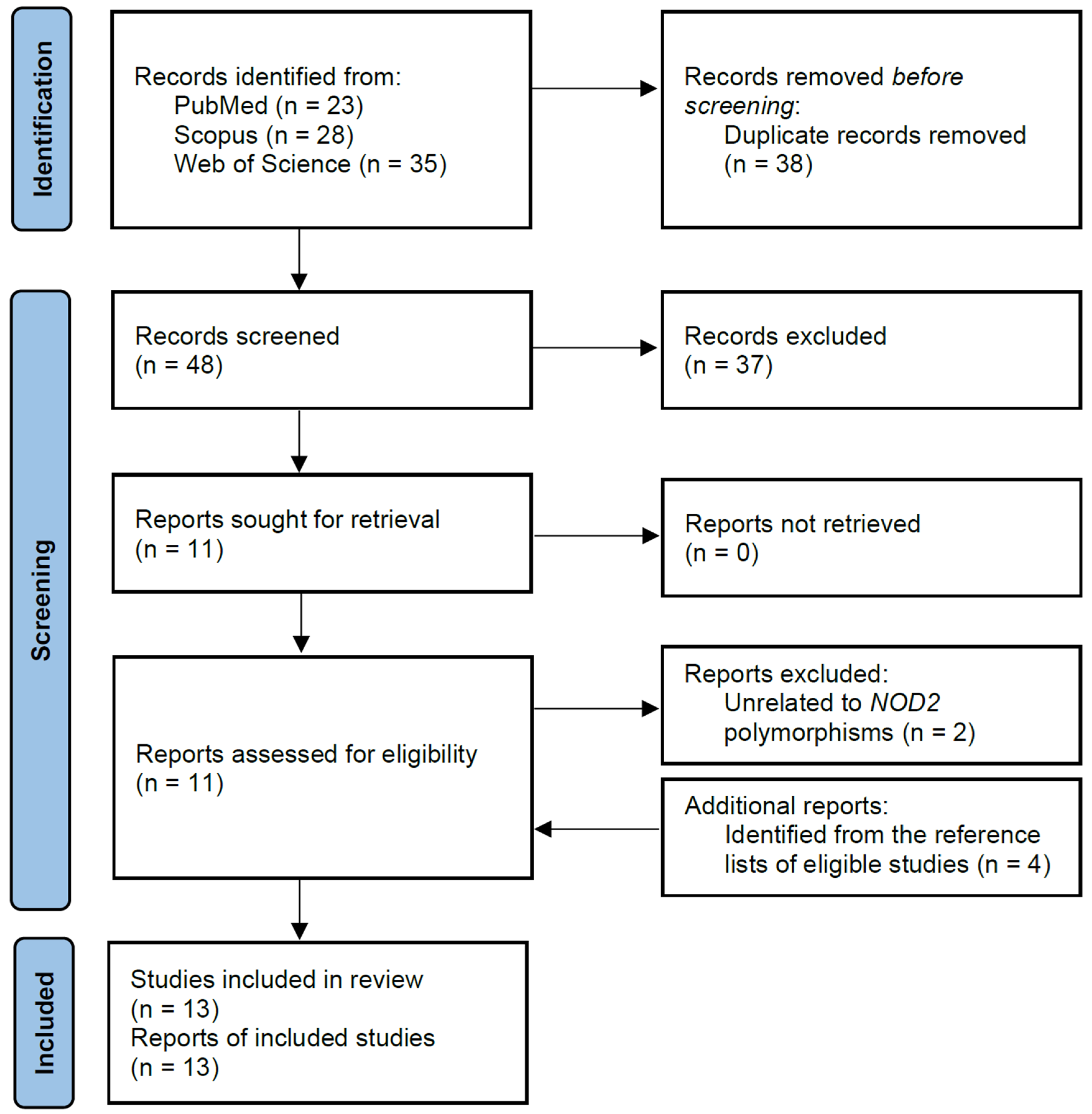
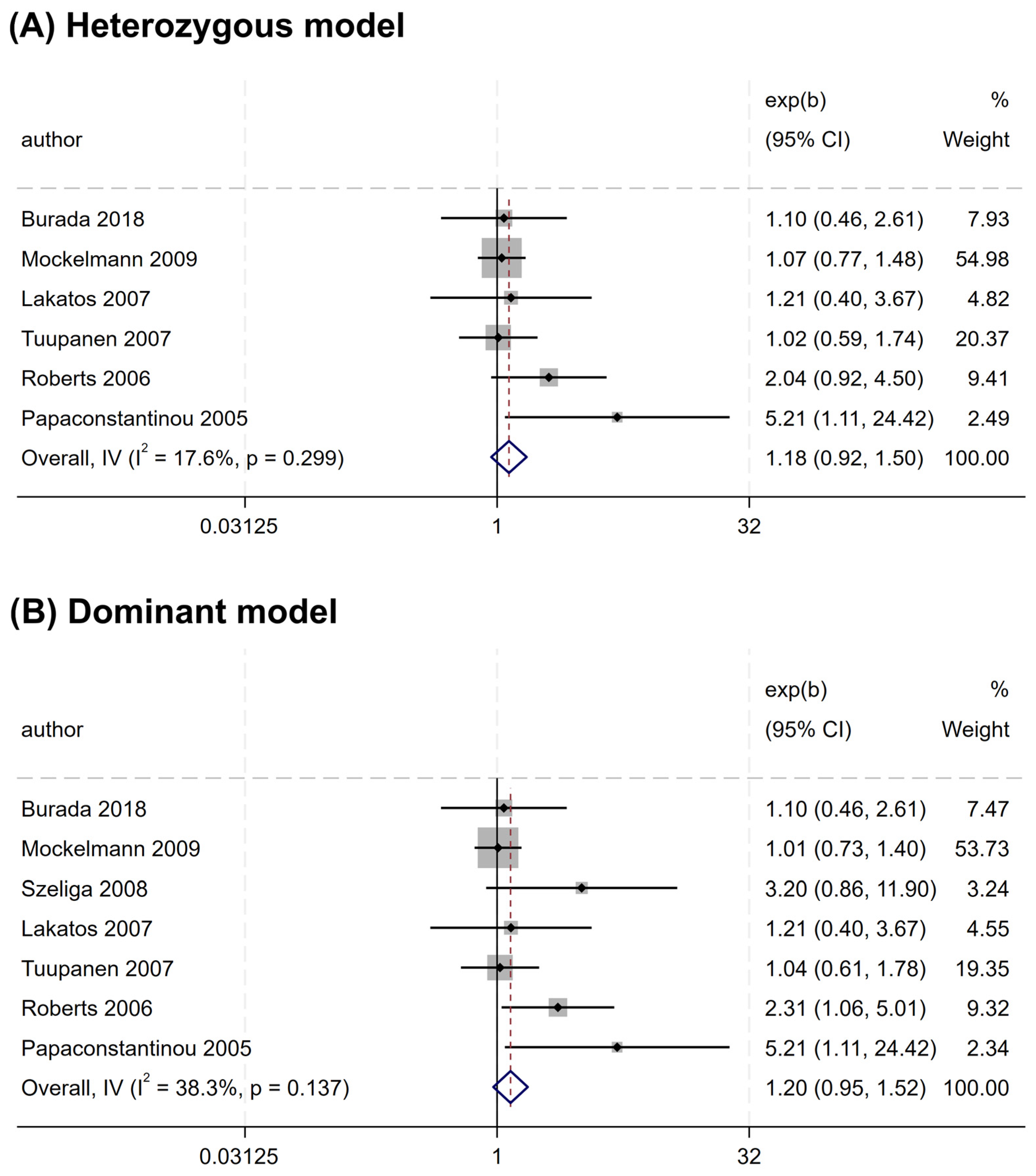
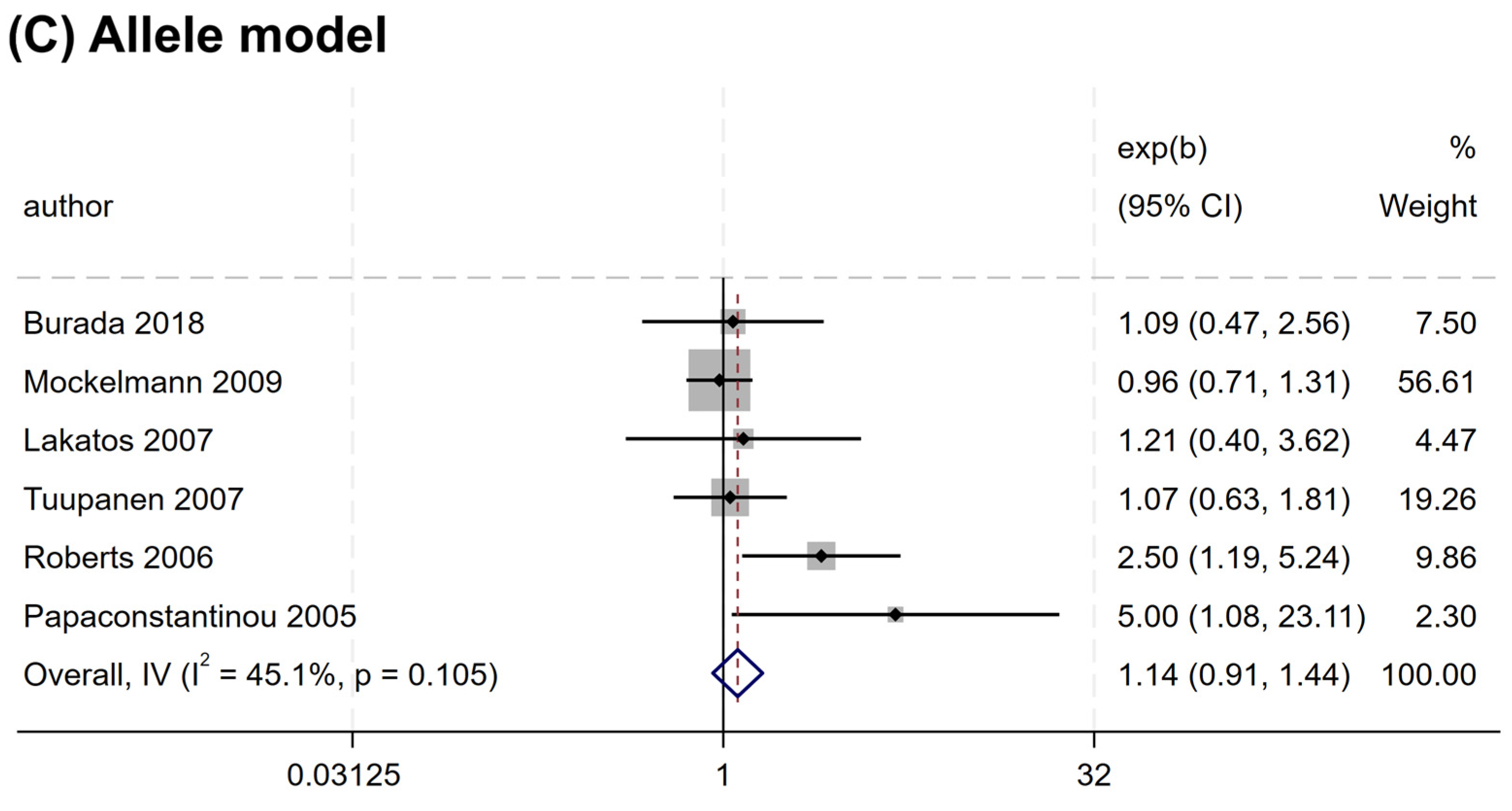
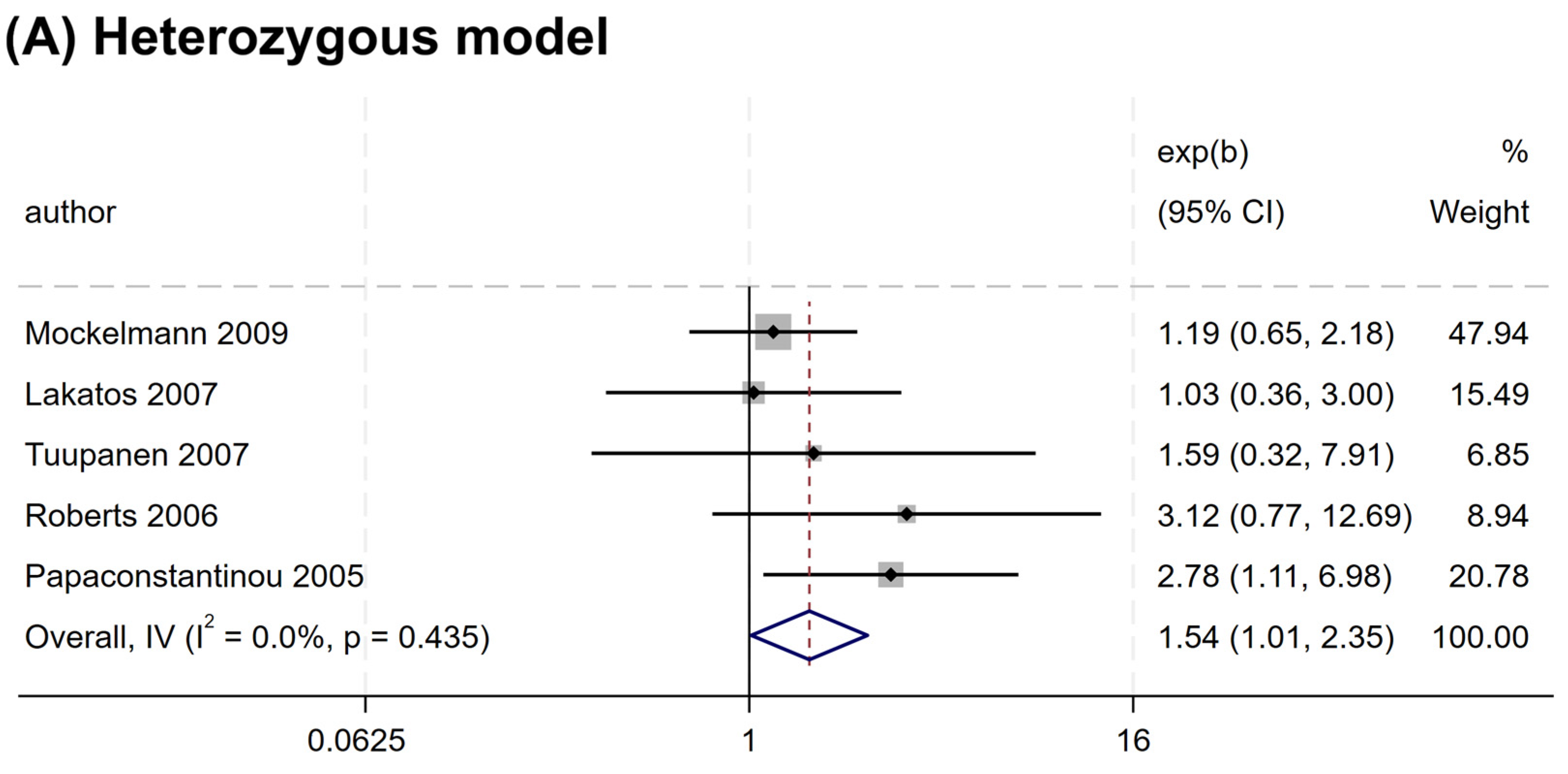
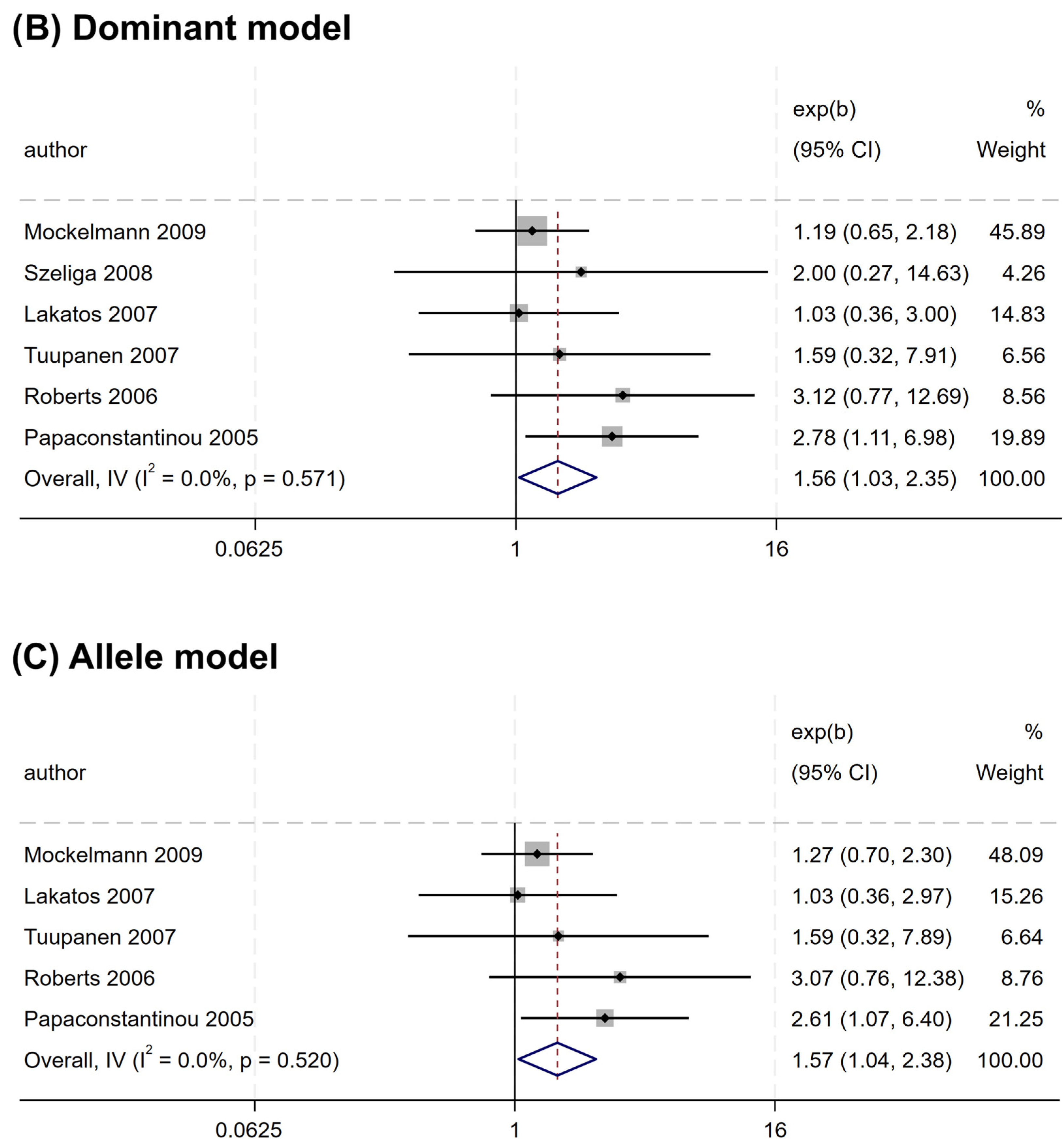
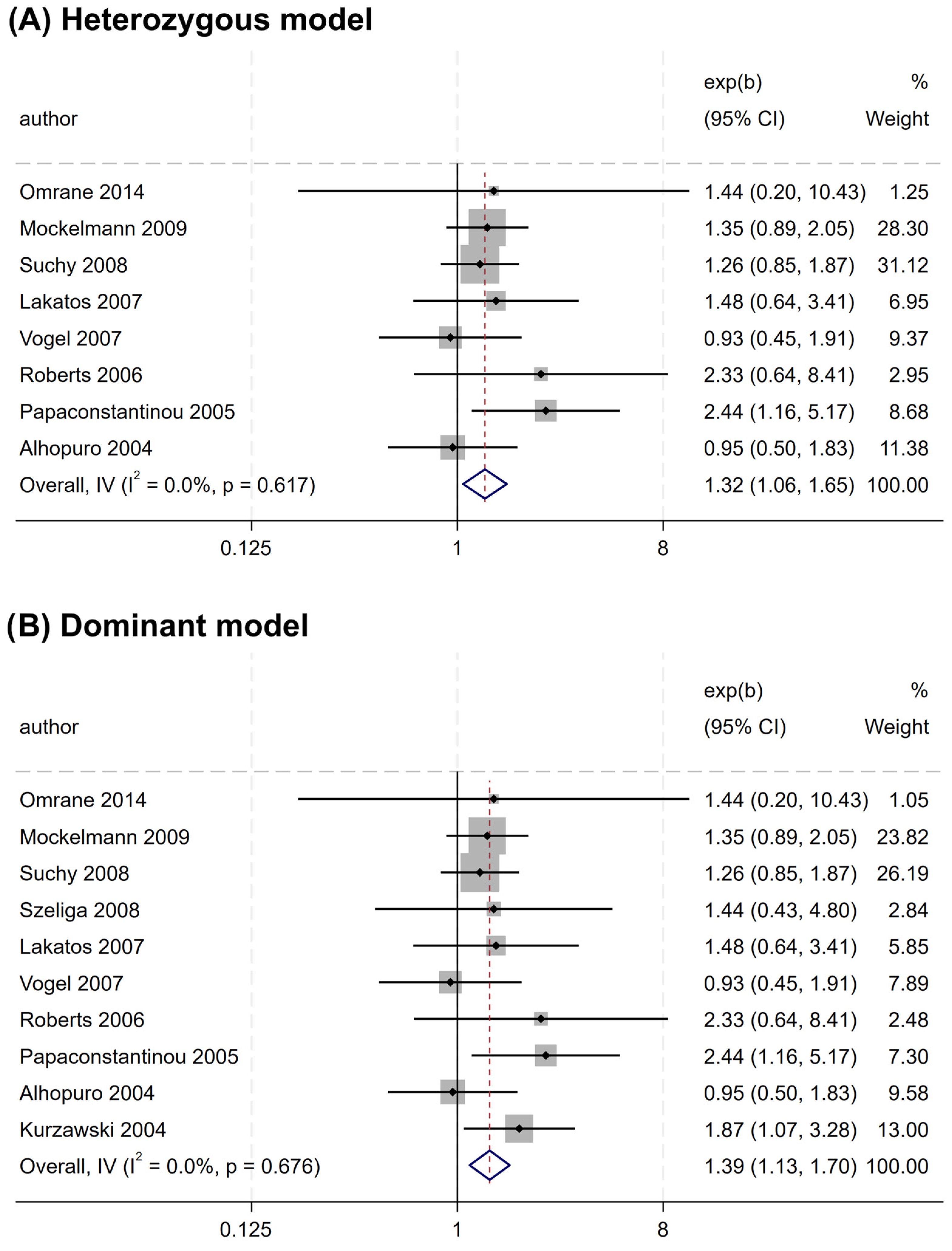
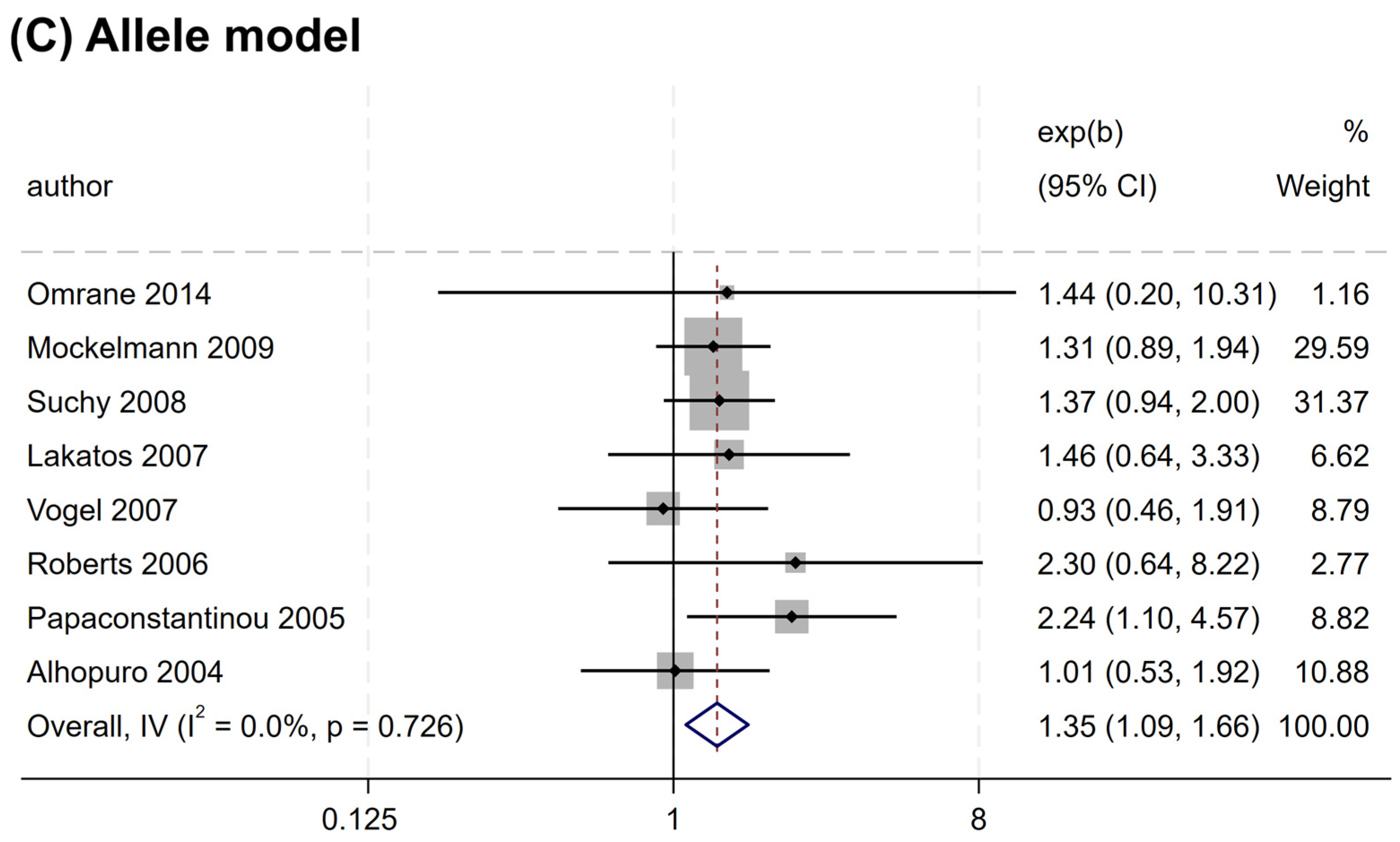
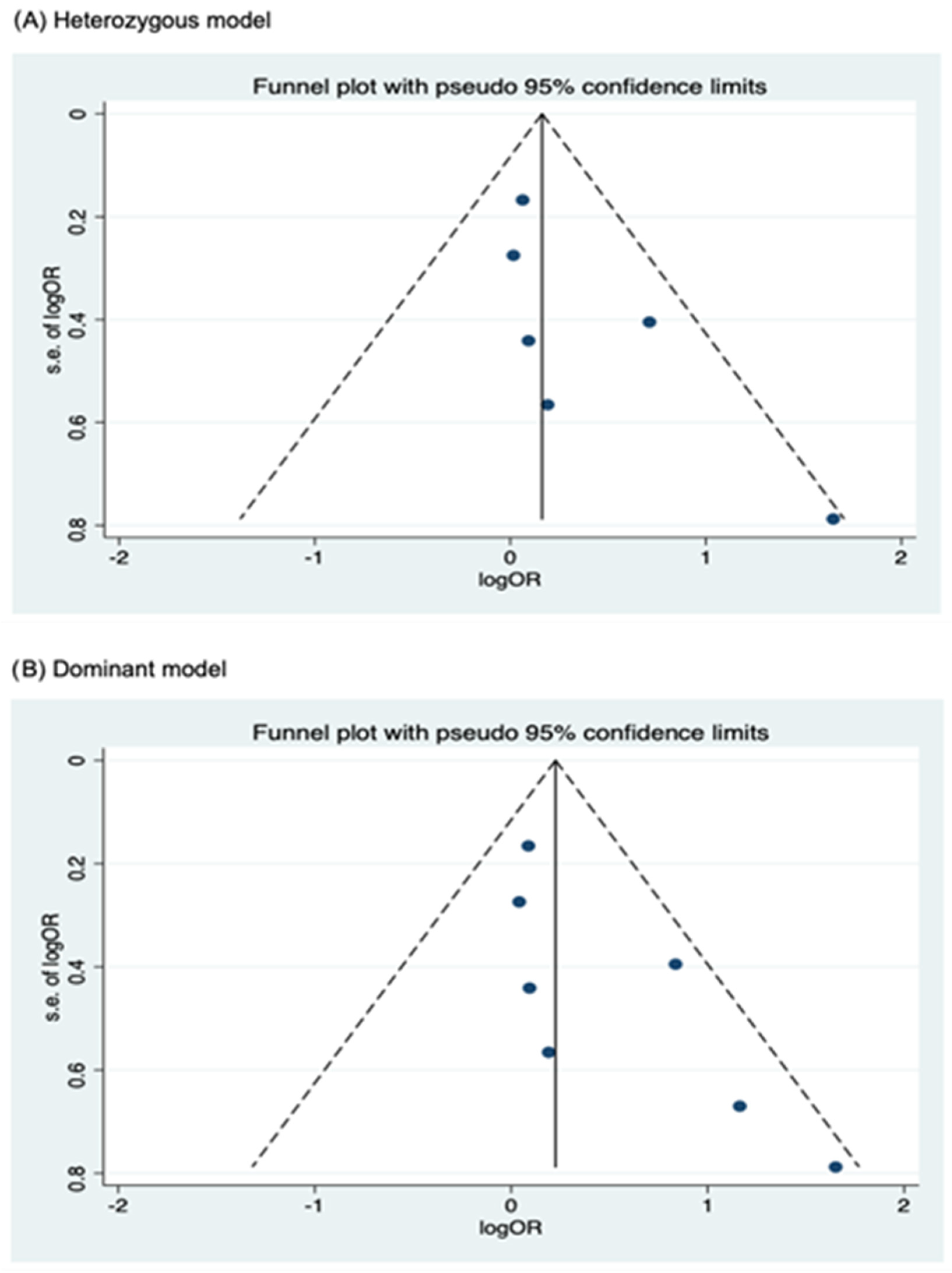
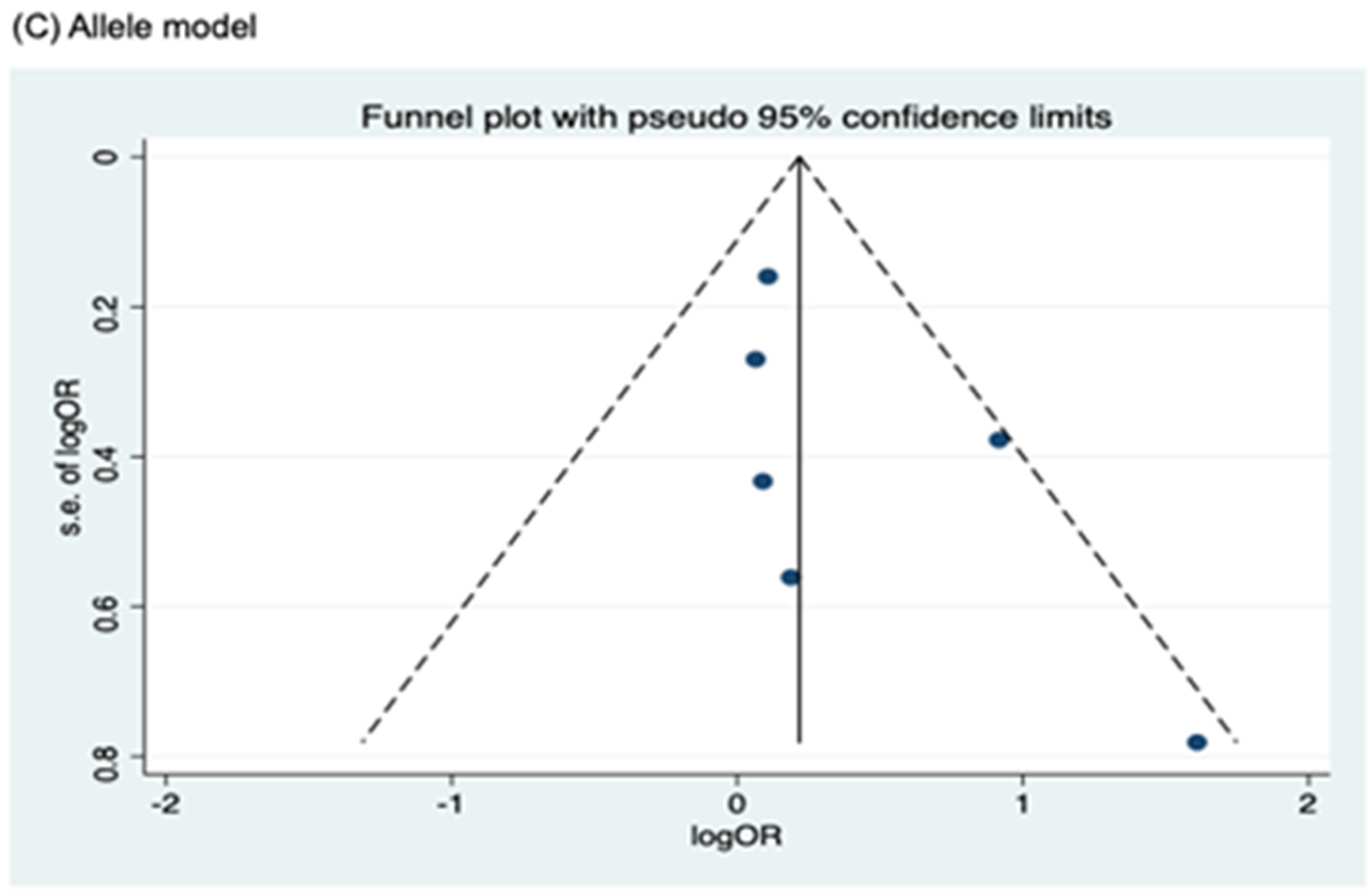
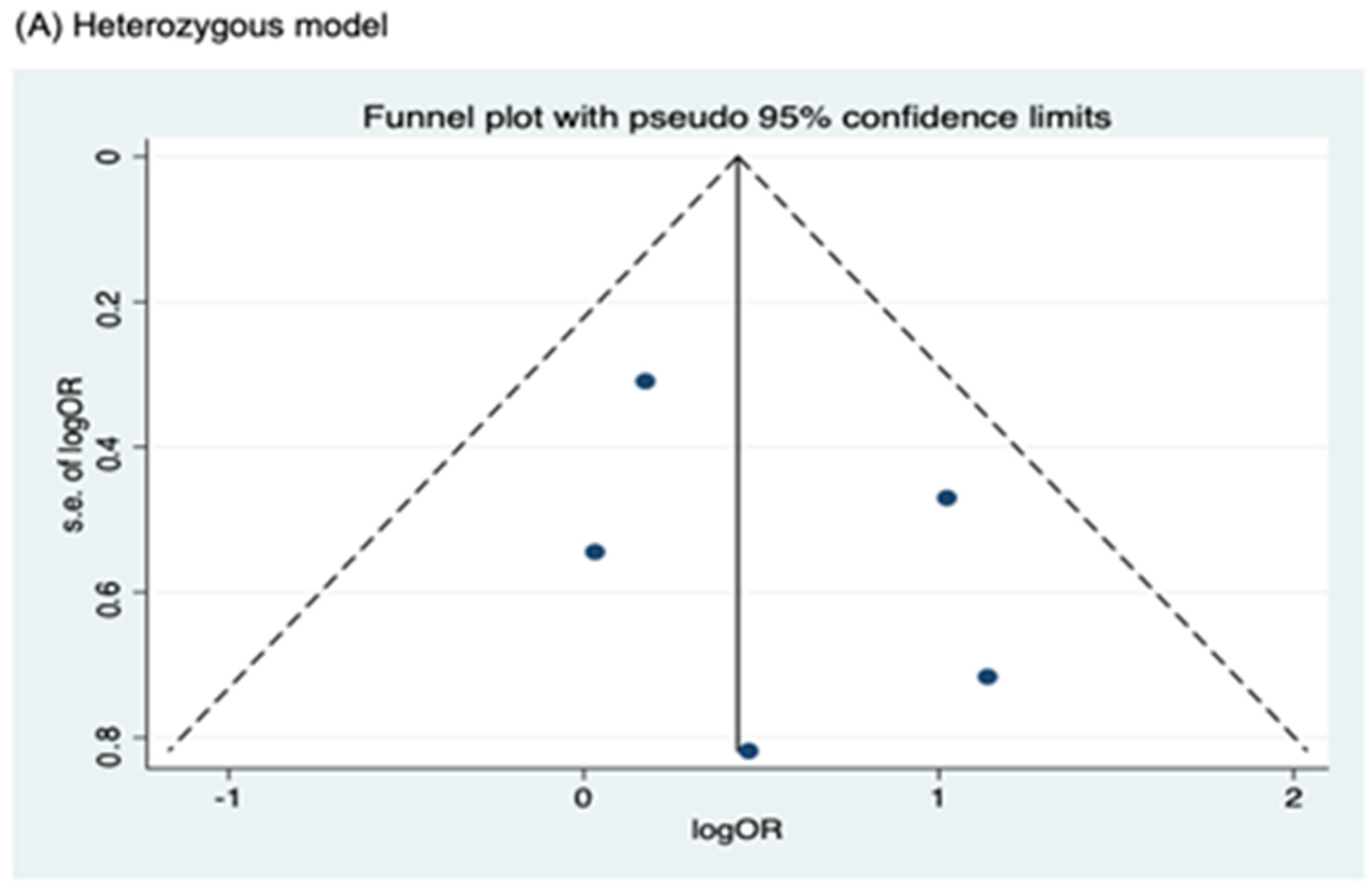
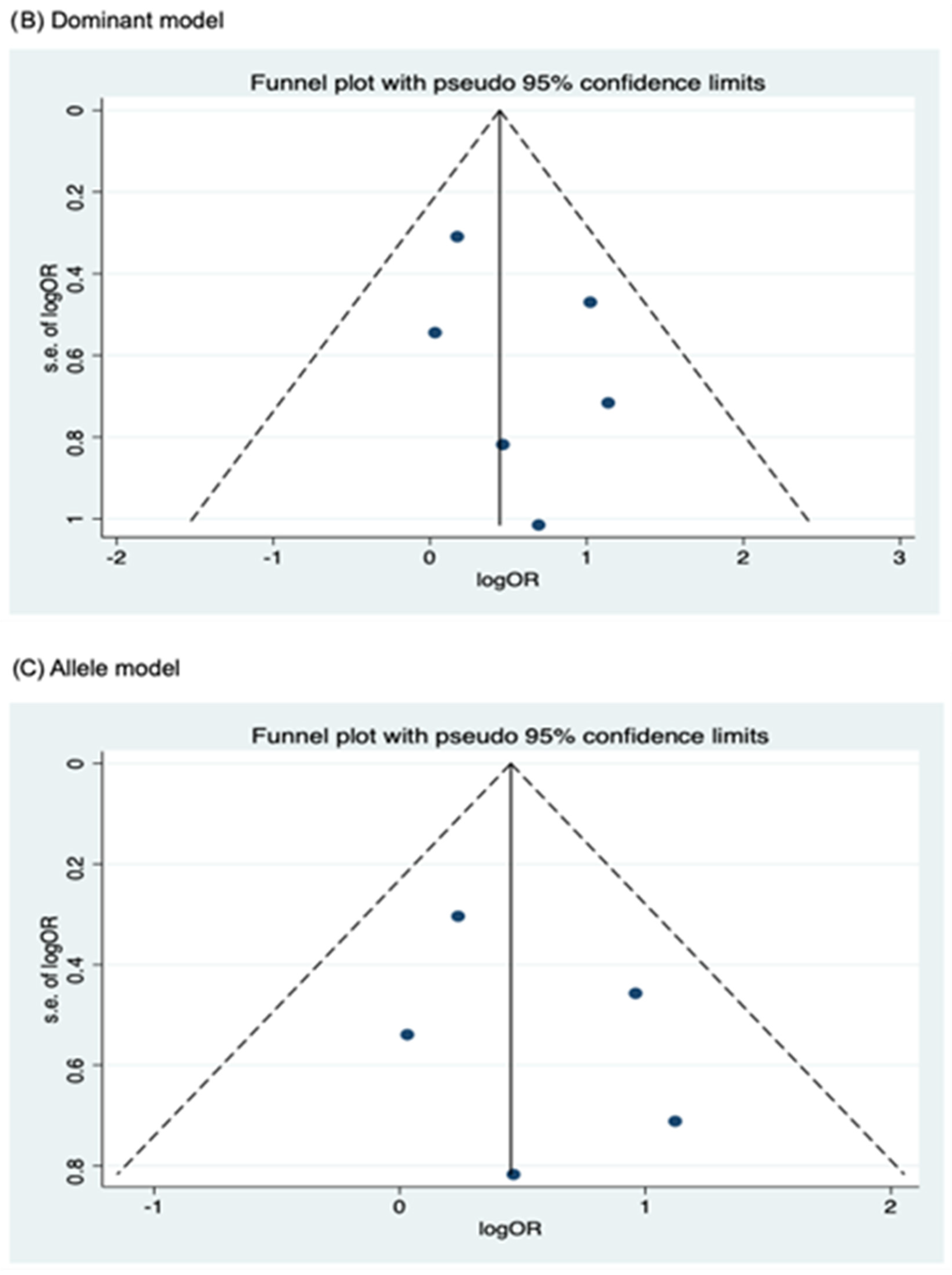
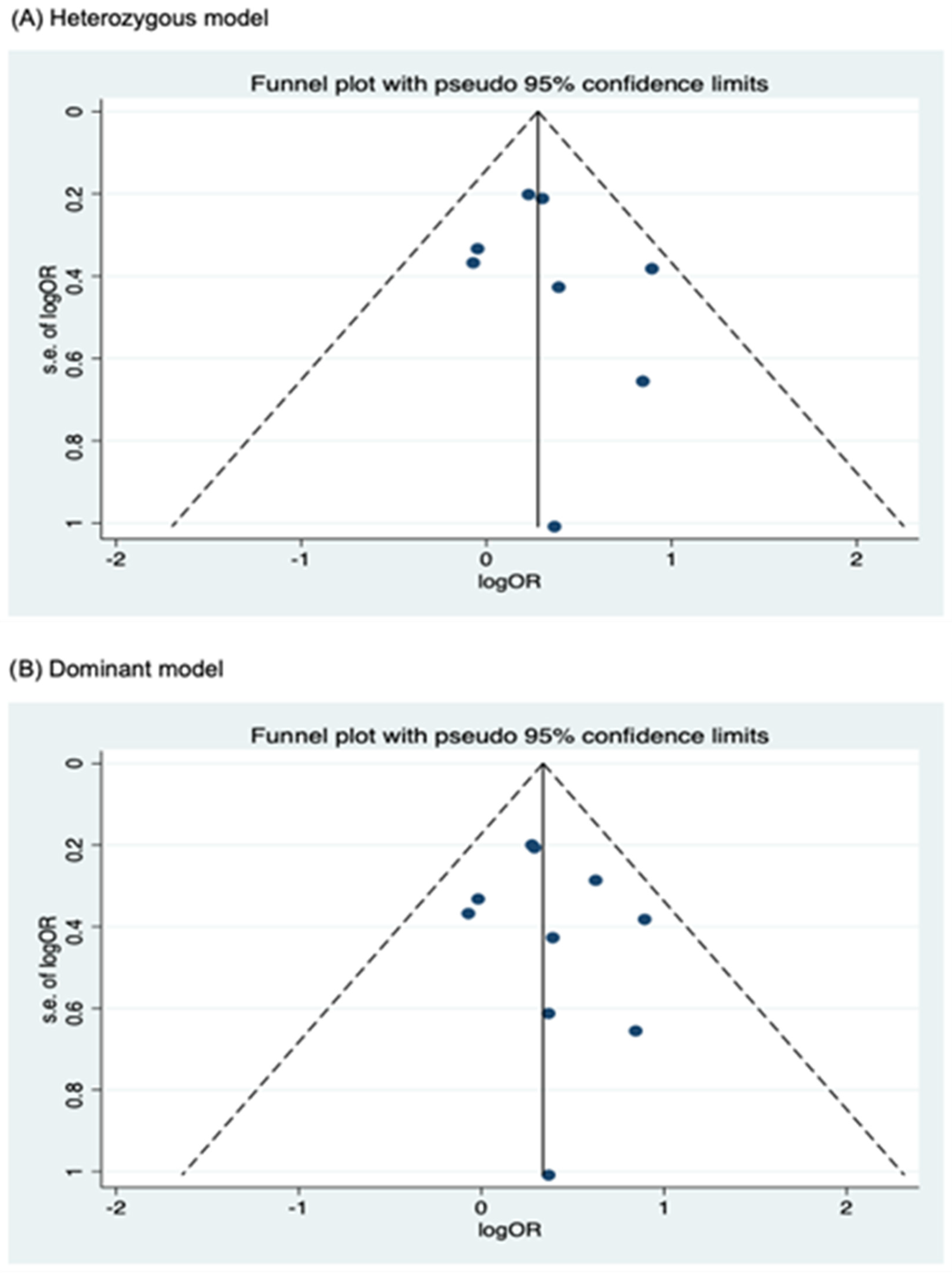
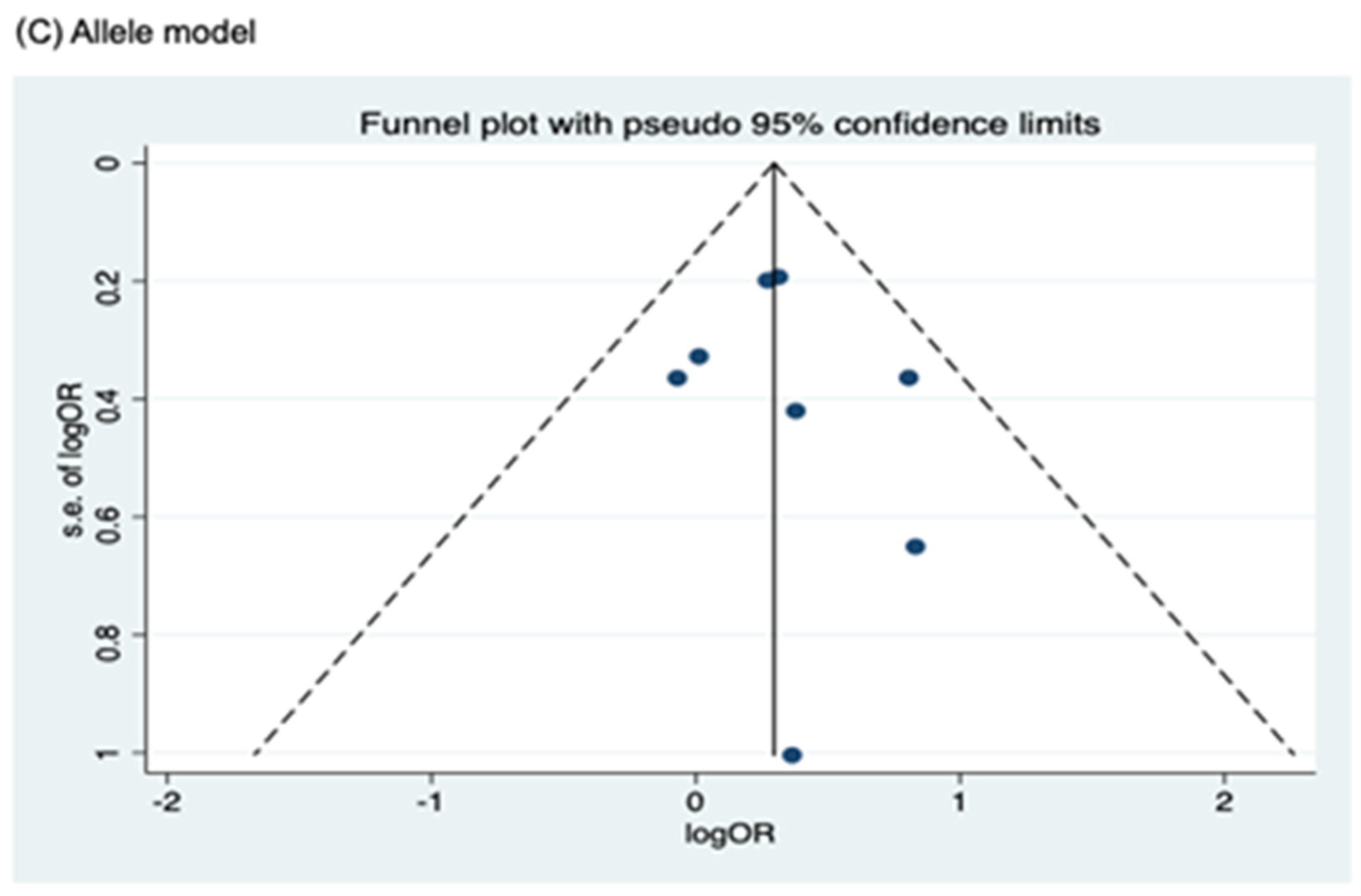
| Study | Year | Country | Ethnicity | Total Subjects | Genotype (Case/Control) | HWE (P Value) | ||
|---|---|---|---|---|---|---|---|---|
| (Case/Control) | Wild-Type | Heterozygous | Variant | |||||
| rs2066844 | ||||||||
| Burada [5] | 2018 | Romania | Other | 108/265 | 100/247 | 8/18 | 0/0 | 0.567 |
| Lakatos [18] | 2007 | Hungary | Caucasian | 194/200 | 187/194 | 7/6 | 0/0 | 0.829 |
| Lau [12] | 2014 | Malaysia | Asian | 130/212 | 130/212 | 0/0 | 0/0 | NA |
| Mockelmann [20] | 2009 | Northern Germany | Other | 1,044/724 | 941/658 | 99/65 | 4/1 | 0.643 |
| Papaconstantinou [21] | 2005 | Greek | Other | 104/100 | 94/98 | 10/2 | 0/0 | 0.919 |
| Roberts [19] | 2006 | New Zealand | Caucasian | 133/201 | 116/189 | 15/12 | 2/0 | 0.662 |
| Szeliga [22] | 2008 | Polish | Other | 51/100 | 45/96 | 6/4 * | NA | |
| Tuupanen [17] | 2007 | Finland | Caucasian | 954/508 | 913/487 | 40/21 | 1/0 | 0.634 |
| rs2066845 | ||||||||
| Lakatos [19] | 2007 | Hungary | Caucasian | 194/200 | 187/193 | 7/7 | 0/0 | 0.541 |
| Lau [12] | 2014 | Malaysia | Asian | 130/212 | 130/212 | 0/0 | 0/0 | NA |
| Mockelmann [20] | 2009 | Northern Germany | Other | 1,044/724 | 1,014/707 | 29/17 | 1/0 | 0.749 |
| Papaconstantinou [21] | 2005 | Greek | Other | 104/100 | 86/93 | 18/7 | 0/0 | 0.716 |
| Roberts [19] | 2006 | New Zealand | Caucasian | 133/201 | 127/198 | 6/3 | 0/0 | 0.915 |
| Szeliga [22] | 2008 | Polish | Other | 51/100 | 49/98 | 2/2 * | NA | |
| Tuupanen [17] | 2007 | Finland | Caucasian | 960/508 | 954/506 | 6/2 | 0/0 | 0.964 |
| rs2066847 | ||||||||
| Alhopuro [24] | 2004 | Finland | Caucasian | 926/348 | 892/335 | 33/13 | 1/0 | 0.722 |
| Kurzawski [25] | 2004 | Poland | Other | 300/300 | 263/279 | 37/21 * | NA | |
| Lakatos [18] | 2007 | Hungary | Caucasian | 194/200 | 180/190 | 14/10 | 0/0 | 0.716 |
| Lau [12] | 2014 | Malaysia | Asian | 130/212 | 130/212 | 0/0 | 0/0 | NA |
| Mockelmann [20] | 2009 | Northern Germany | Other | 1,044/724 | 972/686 | 69/36 | 3/2 | 0.045 |
| Omrane [26] | 2014 | Tunisia | Other | 101/145 | 99/143 | 2/2 | 0/0 | 0.933 |
| Papaconstantinou [21] | 2005 | Greek | Other | 104/100 | 78/88 | 26/12 | 0/0 | 0.523 |
| Roberts [19] | 2006 | New Zealand | Caucasian | 133/201 | 127/197 | 6/4 | 0/0 | 0.886 |
| Suchy [27] | 2008 | Poland | Other | 607/607 | 544/558 | 60/49 | 3/0 | 0.300 |
| Szeliga [22] | 2008 | Polish | Other | 51/100 | 46/93 | 5/7 * | NA | |
| Vogel [28] | 2007 | Danish | Other | 355/753 | 344/728 | 11/25 | 0/0 | 0.643 |
| rs2066842 | ||||||||
| Lau [12] | 2014 | Malaysia | Asian | 130/212 | 126/204 | 4/8 | 0/0 | 0.779 |
| Roberts [22] | 2006 | New Zealand | Caucasian | 133/201 | 86/109 | 37/80 | 10/12 | 0.593 |
| Szeliga [22] | 2008 | Polish | Other | 51/100 | 24/70 | 27/30 * | NA | |
| Study | Selection | Comparability | Exposure | Total Star | |||||
|---|---|---|---|---|---|---|---|---|---|
| Criteria | Criteria | Criteria | |||||||
| 1 | 2 | 3 | 4 | 1 | 1 | 2 | 3 | ||
| Vogel et al. [28] | ✭ | ✭ | ✭ | ✭✭ | ✭ | ✭ | 7 | ||
| Mockelmann et al. * [20] | ✭ | ✭ | ✭/0 | ✭ | ✭✭ | ✭ | ✭ | 7/8 | |
| Lakatos et al. [18] | ✭ | ✭ | ✭ | ✭ | ✭✭ | ✭ | ✭ | 8 | |
| Suchy et al. [27] | ✭ | ✭ | ✭ | ✭✭ | ✭ | ✭ | 7 | ||
| Burada et al. [5] | ✭ | ✭ | ✭ | ✭✭ | ✭ | ✭ | 7 | ||
| Szeliga et al. [22] | ✭ | ✭ | ✭ | ✭✭ | ✭ | ✭ | 7 | ||
| Lau et al. + [12] | ✭ | ✭ | ✭/0 | ✭ | ✭ | ✭ | 5/6 | ||
| Omrane et al. [26] | ✭ | ✭ | ✭ | ✭✭ | ✭ | ✭ | 7 | ||
| Tuupanen et al. [17] | ✭ | ✭ | ✭ | ✭ | ✭✭ | ✭ | 7 | ||
| Alhopuro et al. [24] | ✭ | ✭ | ✭ | ✭ | ✭✭ | ✭ | 7 | ||
| Kurzawski et al. [25] | ✭ | ✭ | ✭ | ✭✭ | ✭ | ✭ | 7 | ||
| Papaconstatinou et al. [21] | ✭ | ✭ | ✭ | ✭✭ | ✭ | ✭ | 7 | ||
| Roberts et al. [19] | ✭ | ✭ | ✭ | ✭ | ✭✭ | ✭ | ✭ | 8 | |
| Contrast Model | Number of Studies | Number of Cases | Number of Controls | Model | OR (95% CI) | POR |
|---|---|---|---|---|---|---|
| Heterozygous model | ||||||
| Overall | 6 | 2530 | 1997 | Fixed | 1.176 (0.922–1.501) | 0.191 |
| Caucasian | 3 | 1278 | 909 | Fixed | 1.258 (0.832–1.903) | 0.277 |
| Other ethnicity | 3 | 1252 | 1088 | Fixed | 1.135 (0.840–1.534) | 0.408 |
| Dominant model | ||||||
| Overall | 7 | 2588 | 2098 | Fixed | 1.253 (0.989–1.589) | 0.062 |
| Caucasian | 3 | 1281 | 909 | Fixed | 1.329 (0.882–2.003) | 0.174 |
| Other ethnicity | 4 | 1307 | 1189 | Fixed | 1.217 (0.910–1.627) | 0.186 |
| Allele model | ||||||
| Overall | 6 | 5074 | 3996 | Fixed | 1.243 (0.983–1.571) | 0.069 |
| Caucasian | 3 | 2562 | 1818 | Fixed | 1.392 (0.932–2.079) | 0.106 |
| Other ethnicity | 3 | 2512 | 2178 | Fixed | 1.172 (0.878–1.564) | 0.281 |
| Contrast Model | Number of Studies | Number of Cases | Number of Controls | Model | OR (95% CI) | POR |
|---|---|---|---|---|---|---|
| Heterozygous model | ||||||
| Overall | 5 | 2434 | 1733 | Fixed | 1.544 (1.014–2.349) | 0.043 |
| Caucasian | 3 | 1287 | 909 | Fixed | 1.557 (0.735–3.297) | 0.248 |
| Other ethnicity | 2 | 1147 | 824 | Random | 1.690 (0.744–3.835) | 0.210 |
| Dominant model | ||||||
| Overall | 6 | 2486 | 1833 | Fixed | 1.561 (1.035–2.354) | 0.034 |
| Caucasian | 3 | 1287 | 909 | Fixed | 1.557 (0.735–3.297) | 0.248 |
| Other ethnicity | 3 | 1199 | 924 | Fixed | 1.562 (0.956–2.552) | 0.075 |
| Allele model | ||||||
| Overall | 5 | 4870 | 3466 | Fixed | 1.572 (1.040–2.375) | 0.032 |
| Caucasian | 3 | 2574 | 1818 | Fixed | 1.547 (0.734–3.261) | 0.251 |
| Other ethnicity | 2 | 2296 | 1648 | Fixed | 1.583 (0.964–2.599) | 0.069 |
| Contrast Model | Number of Studies | Number of Cases | Number of Controls | Model | OR (95% CI) | POR |
|---|---|---|---|---|---|---|
| Heterozygous model | ||||||
| Overall | 8 | 3457 | 3076 | Fixed | 1.321 (1.060–1.647) | 0.013 |
| Caucasian | 3 | 1252 | 749 | Fixed | 1.245 (0.772–2.008) | 0.369 |
| Other ethnicity | 5 | 2205 | 2327 | Fixed | 1.343 (1.047–1.722) | 0.020 |
| Dominant model | ||||||
| Overall | 10 | 3815 | 3478 | Fixed | 1.402 (1.147–1.713) | 0.001 |
| Caucasian | 3 | 1253 | 749 | Fixed | 1.264 (0.784–2.036) | 0.337 |
| Other ethnicity | 7 | 2562 | 2729 | Fixed | 1.434 (1.149–1.788) | 0.001 |
| Allele model | ||||||
| Overall | 8 | 6928 | 6156 | Fixed | 1.345 (1.088–1.663) | 0.006 |
| Caucasian | 3 | 2506 | 1498 | Fixed | 1.276 (0.797–2.043) | 0.311 |
| Other ethnicity | 5 | 4422 | 4658 | Fixed | 1.364 (1.076–1.729) | 0.010 |
Disclaimer/Publisher’s Note: The statements, opinions and data contained in all publications are solely those of the individual author(s) and contributor(s) and not of MDPI and/or the editor(s). MDPI and/or the editor(s) disclaim responsibility for any injury to people or property resulting from any ideas, methods, instructions or products referred to in the content. |
© 2025 by the authors. Licensee MDPI, Basel, Switzerland. This article is an open access article distributed under the terms and conditions of the Creative Commons Attribution (CC BY) license (https://creativecommons.org/licenses/by/4.0/).
Share and Cite
Sharzehan, M.A.K.; Sito, H.; Islam, M.A.; Jamal, R.; Tan, S.C. NOD2 Polymorphisms and Their Association with Colorectal Cancer Risk: An Updated Systematic Review and Meta-Analysis. Cancers 2025, 17, 1999. https://doi.org/10.3390/cancers17121999
Sharzehan MAK, Sito H, Islam MA, Jamal R, Tan SC. NOD2 Polymorphisms and Their Association with Colorectal Cancer Risk: An Updated Systematic Review and Meta-Analysis. Cancers. 2025; 17(12):1999. https://doi.org/10.3390/cancers17121999
Chicago/Turabian StyleSharzehan, Mohamad Ayub Khan, Hilary Sito, Md Asiful Islam, Rahman Jamal, and Shing Cheng Tan. 2025. "NOD2 Polymorphisms and Their Association with Colorectal Cancer Risk: An Updated Systematic Review and Meta-Analysis" Cancers 17, no. 12: 1999. https://doi.org/10.3390/cancers17121999
APA StyleSharzehan, M. A. K., Sito, H., Islam, M. A., Jamal, R., & Tan, S. C. (2025). NOD2 Polymorphisms and Their Association with Colorectal Cancer Risk: An Updated Systematic Review and Meta-Analysis. Cancers, 17(12), 1999. https://doi.org/10.3390/cancers17121999







